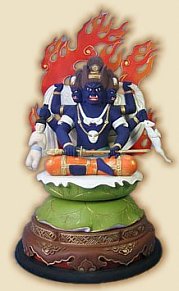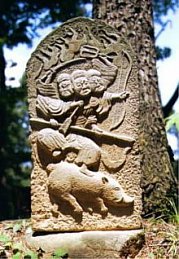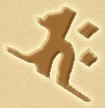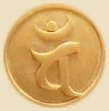|
|
|
|
BEFORE BUDDHISM
India, Hinduism, Hindu Deities,
Sanskrit Seed Syllables, and the Svastikah
This is a side page. Return to Parent Page.
Overview | Hinduism  | Theravada | Mahayana | Vajrayana | Rifts | Theravada | Mahayana | Vajrayana | Rifts
RELATED: Early Buddhism in Japan | Comparing Schools | Guide to Buddhism in Japan
|

The Japanese adopted many
Hindu deities into the Japanese
Buddhist pantheon. In fact, nearly all Buddhist deities have a Hindu
counterpart. For a listing of 80+ Hindu deities & their Japanese equivelents,
see the TENBU (Skt. = Deva) page.
ABOVE: Japanese statue of
Sanmen Daikokuten in the guise of
Daijizaiten. Photo from Butuzou.co.jp
Six Paths
of Karmic Rebirth
Jp. = Rokudō 六道 or
Rokudō-rinne 六道輪廻
Buddhist concept stemming
from Hindu’s karmic philosophies.
In Japan, most commonly
referred to as the Six Paths.

Another Hindu deity adopted into
the Japanese Buddhist pantheon.
Marishiten (goddess of warriors)
at Daiunji Temple 大雲寺
near Kyoto, Photo this J-site
|
|
 Before Birth of Buddhism Before Birth of Buddhism
Around the 15th century BC, India was inhabited by the Aryan people (Indo-European speakers), who developed a caste system that over time became known as Varnashrama Dharma. It consisted of the Brahmin (priests, scholars, teachers) at top, followed by Kshatriya (royalty and warriors), Vaisya (farmers and commoners) and Sudra (lower classes, including artisans). Another separate class, the “untouchables,” consisted of people who were shunned by society, such as those who handled the disposal of dead bodies. The Historical Buddha was born into the Kshatriya (royal) class around 500 BC.
The Aryans also developed a polytheistic folk religion known as Hinduism, and the people of India at the time lived according to the Brahman rites, for Brahma was one of the chief deities of that Hindu age. This early period of Hinduism is referred to as Brahmanism. The written language of the Aryans was Sanskrit -- considered a sacred language for the transmission of the Brahman scriptures and rites.
KARMIC REBIRTH. The Aryans also brought with them a belief in "transmigration" -- more commonly known in the West as reincarnation. It holds that all living things die and are reborn again into a separate existence. Your rebirth into the next life will be based on your behavior in your past life (your Karma). This rebirth occurs again and again. When Buddhism emerged many centuries later, it too stressed this belief in transmigration, one that still plays a major role in modern Buddhist philosophy -- known as the Six Realms of Existence (Skt. = Samsara, the cycle of life and death and rebirth). The modern Buddhist concept of Karma & Karmic Retribution is also a byproduct of ancient Hindu beliefs in transmigration and reincarnation. Buddhism, however, brought the promise of breaking free from the cycle of rebirth -- if one can eliminate desire and attain enlightenment, one is no longer doomed to death and rebirth over countless ages, but attains a state known as Nirvana, the ultimate state for pratitioners of Buddhism.
Followers of the Historical Buddha (died about 480 BC), embroidering the Hindu notions, found their own ways of calculating the ethical karmic balance sheet. They distinquished “deed karman” from “mental karman” (thoughts and motivations), and distinguished deeds from their results. They also attached karma to families and nations. But they kept inviolate their belief in the inevitable balancing of the karmic books.
In the early centuries following the Historical Buddha's death, the sacred Buddhist teachings were transmitted in Pali, the language of the masses, and it was from the Pali that many of the Buddhist teachings were first transmitted to Sri Lanka and Southeast Asia. It took about 1,000 years for the Buddhist teachings to arrive in Japan (6th century AD), but by then Buddhism had spread throughout mainland Asia, China in particular, where the teachings were translated into Chinese. In large part, the Japanese relied on these Chinese translations. In summation, three languages form the bedrock of the modern Buddhist cannon -- Sanskrit, Pali, and Chinese.

Chief Gods of Hinduism and Counterparts in Japanese Buddhism
There are literally hundreds of Hindu deities who were adopted into the Chinese and Japanese Buddhist pantheon, with nearly all Buddhist deities having a Hindu counterparts. Some of the most important are listed below. For a listing of 80+ Hindu deities and their Japanese counterparts, please see the TENBU (Skt. = Deva) page.
 Three Main Gods of Hinduism Three Main Gods of Hinduism
- Siva. Śiva. The "Destroyer." Sanskrit = Mahesvara. Also transliterated in Japan as Makeishura 摩醯首羅. Lord of Cosmic Destruction. In Japan, Siva comes in various forms, including Daikokuten 大黒天, Daijizaiten 大自在天 and Ishanaten 伊舎那天.
- Brahma. Brahmā. The "Creator." Lord who created the world. In Japan, Brahma is known as Bonten 梵天, and is one of the Twelve Deva. Often shown together with Taishakuten 帝釈天 (see Indra below).
- Visnu, Vishnu. Viṣṇu. The "Preserver." Represents ultimate reality, the all-pervading essence. In Japan, Vishnu appears in numerous forms, including Bichuten 毘紐天 (Bichūten), Mishichiju 微瑟紐 (Mishichijū), and Ungyo 吽形 (Ungyō), the latter the closed-mouth Nio Guardian who protects the entrance to the temple. Vishnu's mount is the bird-man deity known in Japan as Karura 迦楼羅. His wife in Hindu myths is the Buddhist deity known in Japan as Kichijoten 吉祥天 (Kichijōten) or Kudokuten 功徳天, the goddess of fortune and merit. In Esoteric Buddhism, he appears as a divinity in the outer court 外金剛部院 (Jp. = Gaikongōbuin) of the Taizokai 胎蔵界曼荼羅 (Taizōkai) mandala. He has many different names, including 那羅延天 (Skt. Nārāyana), 納拉辛哈 (Skt. Narasimha) and 婆藪天 (Skt. Vasudeva).

 Other Major Hindu Deities & Japanese Counterparts Other Major Hindu Deities & Japanese Counterparts
- Indra or Sakra or Śakro devānām indraḥ. A major Hindu god who serves as king of the gods on Mt. Sumeru (Jp. = Shumisen 須弥山), and as a protector of the Historical Buddha (Shaka 釈迦如来). Known as Taishakuten 帝釈天 in Japan, one of the Twelve Deva, and often shown together with Bonten (Skt. = Brahma).
- Sarasvati, Sarasvatī. The Hindu goddess of learning, known as Benzaiten 弁財天 in Japan, where she is worshipped as the goddess of music, poetry, learning, and art. She is one of Japan’s Seven Lucky Gods.
- Myo-o 明王 (Myō-ō, or Mantra Kings). A class of Hindu deities incorporated into Buddhism. They appear in wrathful forms with furious faces, and multipe heads and arms to frighten non-believers into accepting the teachings of Dainichi Buddha 大日如来 (Skt. = Vairocana or Mahavairocana).
- 12 Deva Guardians (Jp. = Jūniten 十二天). Deities of the 12 directions in Esoteric Buddhism, including the four directions and four semi-directions, up and down, and sun and moon. Deva, a Sanskrit term meaning celestial being, is rendered as "Ten 天" in Japan (the latter literally means Heaven). The Deva are deities borrowed from Hindu mythology and adopted into Chinese and Japanese Buddhism as guardians of the monasteries of Esoteric Buddhist. They appear frequently in the Japanese mandala. Among the twelve, Bonten (Brahma) and Taishakuten (Indra) serve in the highest position. See the TENBU page for many more deva.

Svastikah 卍
Source:
Bernard Faure
Symbolism of the Kasaya in Soto Zen. 1995, pp 335-369
|
|
 From Hinduism. Called Kyoji 胸字 (Kyōji) in Japan. It originated in India, and was often engraved on the chest of the Hindu deity Vishnu. It was incorporated by Buddhism and often appears on statues of the Buddha (Jp. = Nyorai 如来) and Bodhisattva (Jp. = Bosatsu 菩薩). It is also one of the 32 Marks of the Buddha (Sanjūnisō 三十二相). In Japan it represents the ”possession of all virtues” and is used as a symbol of Buddhist faith. This marking, when duplicated, turning one clockwise and the other counterclockwise, combines to form the Japanese character for FIELD 田, which symbolizes the “robe of the formless field of merit” -- a robe that is still sewn and worn by Japanese Buddhist clergy even today. See above chart for creating the “field” with two Kyoji. From Hinduism. Called Kyoji 胸字 (Kyōji) in Japan. It originated in India, and was often engraved on the chest of the Hindu deity Vishnu. It was incorporated by Buddhism and often appears on statues of the Buddha (Jp. = Nyorai 如来) and Bodhisattva (Jp. = Bosatsu 菩薩). It is also one of the 32 Marks of the Buddha (Sanjūnisō 三十二相). In Japan it represents the ”possession of all virtues” and is used as a symbol of Buddhist faith. This marking, when duplicated, turning one clockwise and the other counterclockwise, combines to form the Japanese character for FIELD 田, which symbolizes the “robe of the formless field of merit” -- a robe that is still sewn and worn by Japanese Buddhist clergy even today. See above chart for creating the “field” with two Kyoji.
The Kyōji 卍 (Skt. = Svastikah) became one of the most frequently used symbols in early Buddhism. Unfortunately, many centuries later it was misappropriated by Nazi Germany and called the Swastika.The German term Swastika comes from the Sanskrit word Svastikah, the latter meaning “to be fortunate.” The word stem SVASTI can be divided into SU (SV), meaning “good or well,” and ASTI (ASTIKAH), meaning “is” or “being.” In modern India, the word means “auspicious.”

Sanskrit Seed Syllables, Siddham, & Bonji
|

Baku (Jp. Pronunciation)
Shaka’s Seed Syllable

Ban (Jp. Pronunciation)
Dainichi’s Seed Syllable
Kiriku (Jp. Pronunciation
Amida’s Seed Syllable |
|
 In Japan, the generic term for "Sanskrit" is Bonji (梵字) or Bongo (梵語). The Japanese word for Seed Syllable is Shuji 種字 (Sanskrit = Bijaksara). In Japan, Sanskrit seed syllables are written in a script called Shittan 悉曇 (Sanskrit = Siddham). In Japanese Buddhist statuary, Buddhist deities are typically assigned a special seed syllable, one that is often inscribed somewhere on the statue or halo. Deities are also assigned mantras (Jp. = Shingon 真言) that contain these seed syllables -- the mantra is a magical incantation, a secret prayer, a special chant used to invoke the essence of the deity. Furthermore, Japan's esoteric sects also employ a mandala called the Seed-Syllable Mandala (Shuji Mandara 種字曼荼羅), in which the deities are symbolized by their individual seed syllables. A special version of this mandala, known as the Shiki Mandara (Shiki Mandara 敷曼荼羅) is used in initiation rites among esoteric sects. The initiand casts a flower onto the spread-out mandala, and the seed syllable on which it falls then becomes the patron deity of the intiand. In Japan, the generic term for "Sanskrit" is Bonji (梵字) or Bongo (梵語). The Japanese word for Seed Syllable is Shuji 種字 (Sanskrit = Bijaksara). In Japan, Sanskrit seed syllables are written in a script called Shittan 悉曇 (Sanskrit = Siddham). In Japanese Buddhist statuary, Buddhist deities are typically assigned a special seed syllable, one that is often inscribed somewhere on the statue or halo. Deities are also assigned mantras (Jp. = Shingon 真言) that contain these seed syllables -- the mantra is a magical incantation, a secret prayer, a special chant used to invoke the essence of the deity. Furthermore, Japan's esoteric sects also employ a mandala called the Seed-Syllable Mandala (Shuji Mandara 種字曼荼羅), in which the deities are symbolized by their individual seed syllables. A special version of this mandala, known as the Shiki Mandara (Shiki Mandara 敷曼荼羅) is used in initiation rites among esoteric sects. The initiand casts a flower onto the spread-out mandala, and the seed syllable on which it falls then becomes the patron deity of the intiand.
Kukai 空海 and Sanskrit in Japan
Sanskrit seed syllables are easy to spot in Japan. They are found on Japanese Buddhist amulets, gravestones, religious statuary, mandala artwork, and other objects, both old and new. By tradition, the introduction of seed syllables to Japan is credited to Kukai (Kūkai; +774-835), also known as Kobo Daishi 弘法大師 (Kōbō Daishi), who studied the main Chinese calligraphic scripts and Sanskrit Siddam while visiting China in the early 9th century, and brought back copies of the Seed-Syllable Mandala (see prior paragraph). Today he acclaimed as one of the Three Brushes (Jp = Sanpitsu 三筆 or Three Great Calligraphers) of Japan. On his return from China, he founded Japan’s Shingon 真言 sect of Esoteric Buddhism 密教 (Mikkyō). He played an active role in many fields, performing rituals for the emperor, constructing a large reservoir in Shikoku for the common people, and establishing the first school for common citizens. His legend is riddled with folklore. He is credited with everything from inventing Japan’s kana script to introducing homosexuality. He is one of Japan’s most celebrated calligraphers, and supposedly published Japan’s first dictionary. He became a major patron of the arts, and reportedly founded hundreds of temples across Japan. The Shikoku Pilgrimage to 88 Sites is a popular pilgrimage attributed to Kukai.
Over time, Kukai's Sanskrit syllabary was modified to better fit the Japanese lexicon. Since the time of Jōgon 浄厳 (+1639-1702), the Japanese-Sanskrit syllabary has traditionally consisted of 50 phonetic sounds (五十字門). A chart of the 50 is shown below.

Courtesy www.kuubokumon.com/bonji.html
Please visit above link for much larger version
Other Sanskrit-Related Sites

LEARN MORE
- Gods of Hinduism & Counterparts in Japan Nearly all Buddhist deities have a Hindu counterpart. For a listing of 80+ Hindu deities and their Japanese counterparts, please see the TENBU (Skt. = Deva) page. Or view the individual deity pages (see left column). The Sanskrit name for most appears at the top of each individual page.
- Hindu Monkey Deities and Their Impact on Japanese Buddhism. See the Monkey Pages to explore the impact of Hindu monkey lore on Buddhism in Japan.
- Chaudhuri, Saroj Kumar. Hindu Gods and Goddesses in Japan. Vedams, 2003, xviii, 184 p, ISBN : 81-7936-009-1. See partial preview of book at Google Online Book Preview.

|
|